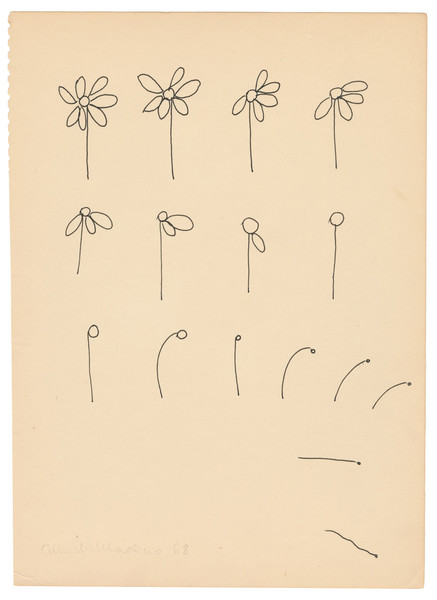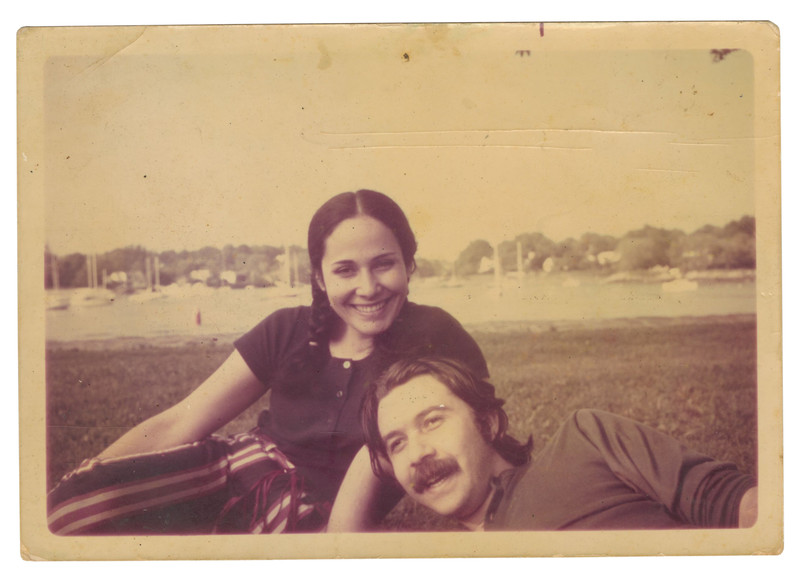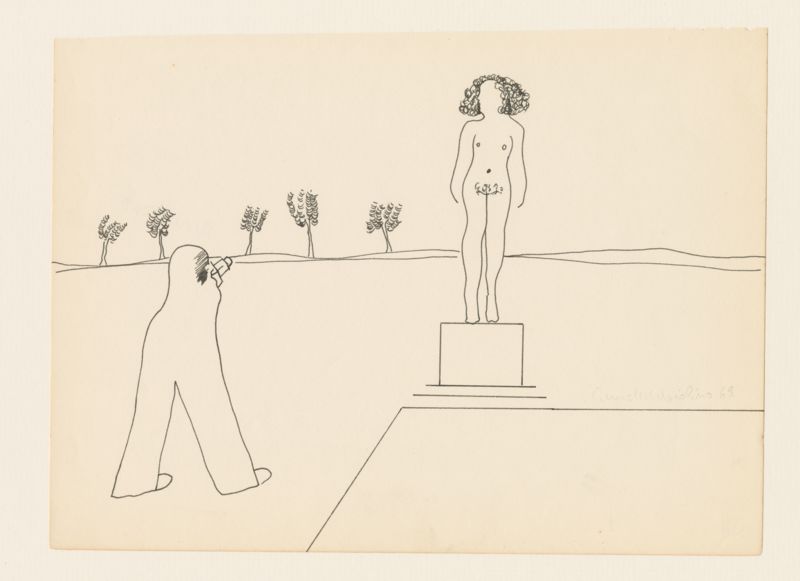Books, Essays
Excerpt from Anna Maria Maiolino: Entre Pausas
(Outside – and Inside)Tania Riviera

From the series 'Entre Pausas (Between Pauses)', 1968-69 © Anna Maria Maiolino
Poetic observations. Isolated verses, yet constructed like a haiku. Gestures inscribed on paper. Through graphic short narratives and scenes, the series ‘Entre Pausas (Between Pauses)’ opens a crease in the world – that same crease in which the art of Anna Maria Maiolino has pulsated ever since.
New York, fifty years ago. Following her first solo exhibition of woodcut engravings in Rio de Janeiro, Anna arrives with her husband Rubens Gerchman, who had been granted a scholarship. Overrun by housework and two small children, she is forced to put her artistic journey on hold. Packed in her luggage is a sketch pad with drawings she had started some time before; one of her ideas is to become an illustrator in order to achieve financial independence. She remembers the sketch pad when her friend, Hélio Oiticica, aware of her troubles, advises her to write, take notes, draw or scribble on paper, whenever she has a split second free from her daily chores. ‘One word, anything...’ recalls Anna, ‘it will be a record of existence.’

Anna Maria Maiolino and Rubens Germchmann, New York, 1969 © Anna Maria Maiolino

From the series 'Entre Pausas (Between Pauses)', 1968-69 © Anna Maria Maiolino
But, more than just a record, the artist makes this into her very existence. ‘Being an artist, a woman, has been part of one and the same repertoire since the start,’ she says in a short text from 1997 entitled Vir a ‘ser’ ([Coming to ‘be’]; first published in ‘Anna Maria Maiolino: Vida Afora / A Life Line,’ ed. by Catherine de Zeger, New York: The Drawing Center 2002, p. 281). From this multifarious repertoire – which, over the following decades, would intricately unfold through sculptures, installations, performances, works on paper, texts, photography, films and audio works – ‘Entre Pausas’ bears the original gesture: the construction of an alphabet. ‘My alphabet,’ says the artist, who recently became acquainted with the homonymous book that recounts the experience of a child named Julia Kristeva, in celebrating Slavic Cultures and Writing Day, in Sofia.
On that day, everyone was holding a large Cyrillic letter to their chest, and Kristeva stated: ‘I am also a letter. A hyphen connecting others, a swirl of language, a propeller of meaning.’ Anna is also a letter, or rather, she is that which constitutes every letter, but always persists beyond herself: a line. The line that is produced in some corporal gestures, and is consolidated when cutting out and rebuilding the world, turning into a hyphen, a trace. Launching and twisting itself into our lives, intermittently (between pauses) and always moving. The artist’s alphabet is not composed, therefore, of discrete and arbitrary signs that are combined into words and phrases of a language in order to build a shared meaning. The arrangement of lines that it produces refuses to be held back and paralyzed as a sign, nor will it bend to the traits of a single language. Nomad and foreign, like Anna herself, it merges between and mixes languages – Calabrian dialect, Italian, Portuguese, Spanish – sounds and matter.

Anna Maria Maiolino and Rubens Germchmann, New York, 1969 © Anna Maria Maiolino

Anna Maria Maiolino and Rubens Germchmann, New York, 1969 © Anna Maria Maiolino
Carrying through the idea of the letter-line, I like to think of the drawing in ‘Entre Pausas’ as ideograms with no fixed meaning. Like in certain haiku, they shift and transform, between figure and word, becoming at once both poem and drawing. Some explicitly outline the idea of transformation: a flower loses its petals until becoming a dot and a horizontal line; a caterpillar morphs into a butterfly, freeing itself into flight after kissing a flower. A woman is wrapped in a bandage, like a mummy or perhaps one of the faceless statues that in other drawings appear like an inert monument (but that might be hiding a body, a person, as the footprints on the ground suggest in one of them). A man, sitting comfortably on an armchair, holds the end of the bandage. Maybe he is making her spin, and she is becoming body and line - initially united, then gradually separating from each other as they draw (themselves) in space. One day Anna told me a poetic daydream that she had had many years ago: a line would emerge from her belly button to join the line of the horizon. Since reading this remark, every scribbled mark, line and tear the artist makes has acquired another depth in my eyes.
Since then I have seen her art work like a connection between what is most intimate to each of us (our belly buttons) and what is common to us all, like the horizon – which we see together and share, despite being immaterial and moving, recreating itself each moment, depending on our own position on the Earth's surface. – An excerpt from the essay (Outside – and Inside) by Tania Riviera ‘Entre Pausas’ (Between Pauses) is a new artist book that publishes 74 drawings from Maiolino’s eponymous series for the first time. Also featured are a number of photographs from Maiolino’s personal archive, as well as two poems and an account of her time in New York written by the artist, along with contributions by Brazilian psychoanalyst Tania Rivera and Randy Kennedy. A selection of Maiolino’s ‘Entre Pausas’ drawings are on view as part of ‘ERRÂNCIA POÉTICA (POETIC WANDERINGS)’, on view at Hauser & Wirth New York, 22nd Street through 22 December 2018.
